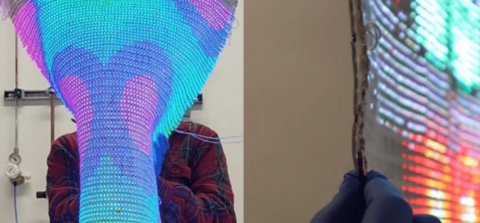
photo: © University of Cambridge
Researchers have developed an easily scalable way to incorporate electronic, sensing, energy, and photonic functions into a piece of textile
An international team of scientists, led by researchers at the University of Cambridge, has developed a woven fibre-optic display. The fibre-based system incorporates electronic, sensing, energy, and photonic functions. The approach could lead to innovations that turn science fiction into reality – such as curtains that act as TVs, carpets that harvest energy when you walk on them, and self-powered clothing.
To create the display, researchers integrated specialised fibres into textiles using conventional weaving and knitting processes. The fibres were first coated with materials that can withstand stretching. Some of the components were then braided to improve their durability. Multiple fibre components were connected together using conductive adhesives and laser welding techniques.
Prior to this work, it has not been possible to manufacture textiles incorporating these functions at scale, or using standard textile manufacturing processes. However, by combining techniques, the researchers were able to include a number of different functions into one large piece of woven fabric, that was manufactured using a standard process.
The result is a scalable fabric that can act as a display, monitor various inputs, or store energy for later use. The fabric can also detect radio frequency signals, touch, light and temperature. Research co-lead Dr Luigi Occhipinti explained that, “By unleashing the full potential of textile manufacturing, we could soon see smart and energy-autonomous Internet of Things devices that are seamlessly integrated into everyday objects and many other sector applications.”
As the internet of things gathers pace, one emerging issue will be how to meet the energy demand of all these electronic devices without contributing to carbon emissions. Generating energy from textiles may be one solution. However, previous innovations covered here, including a textile that generates electricity from sweat, and a fabric that incorporates a piezoelectric yarn, were not easily and cheaply scalable.